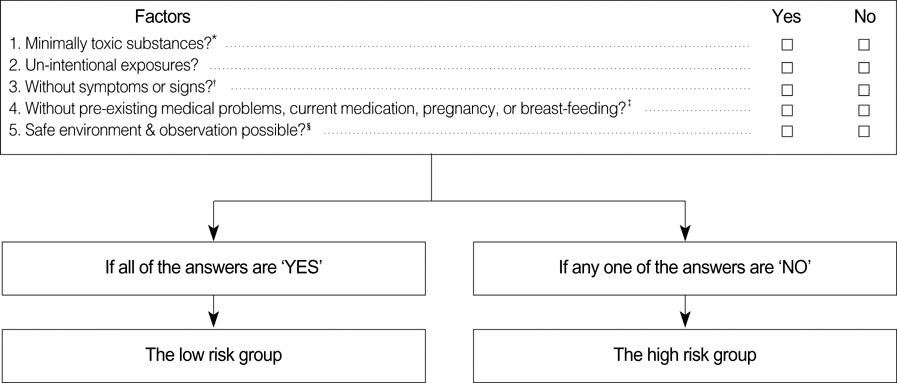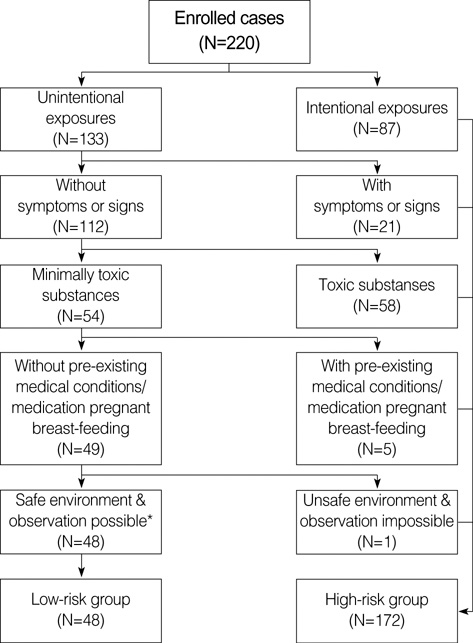J Korean Med Sci.
2007 Apr;22(2):336-341. 10.3346/jkms.2007.22.2.336.
Triage Method for Out-of-Hospital Poisoned Patients
- Affiliations
-
- 1Department of Emergency Medicine, Seoul National University College of Medicine, 28 Yeongeon-dong, Jongno-gu, Seoul, Korea. suhgil@snu.ac.kr
- 2Seoul Emergency Medical Information Center, Seoul National University College of Medicine, Seoul, Korea.
- 3Department of Emergency Medicine, Kangwon National University College of Medicine, Chunchon, Korea.
- 4Department of Emergency Medicine, Samsung Medical Center, Sungkyunkwan University School of Medicine, Seoul, Korea.
- KMID: 1713197
- DOI: http://doi.org/10.3346/jkms.2007.22.2.336
Abstract
- The aim of this study was to develop and evaluate a triage method to prevent unnecessary emergency department visits of out-of-hospital poisoned patients. From October 2003 to September 2004, the calls that lay persons gave to the Seoul Emergency Medical Information Center to seek advices on the out-of-hospital poisoned patients were enrolled. We designed a triage protocol that consisted of five factors and applied it to the patients. According to the medical outcomes, we classified the patients into two groups, the toxicity-positive and the toxicity-negative. We arranged the factors on the basis of the priority that was determined in order of the odds ratio of each factor for the toxicity-positive and made a flow chart as a triage method. Then we calculated a sensitivity, specificity, positive predictive value and negative predictive value of the method. We regarded the specificity as the ability of the method and the sensitivity as the safety. A total of 220 patients were enrolled in this study. The method showed a sensitivity, specificity, positive predictive value, and negative predictive value of 99.2%, 53.4%, 76.2%, and 97.9%, respectively. Our triage method prevented 53.4% of the unnecessary emergency department visits of outof-hospital acutely poisoned patients, safely.
MeSH Terms
-
Triage/methods/*organization & administration
Telephone
Telemedicine/methods/*organization & administration
Severity of Illness Index
Sensitivity and Specificity
Risk Factors
Risk Assessment/*methods
Reproducibility of Results
Prognosis
Poisoning/*diagnosis/*therapy
Male
Korea
Humans
Female
Emergency Medical Services/methods/*organization & administration
Decision Trees
*Decision Support Techniques
Child, Preschool
Child
Adult
Adolescent
Figure
Reference
-
1. Shin SD, Suh GJ, Rhee JE, Sung J, Kim J. Epidemiologic characteristics of death by poisoning in 1991-2001 in Korea. J Korean Med Sci. 2004. 19:186–194.
Article2. Litovitz TL, Klein-Schwartz W, White S, Cobaugh DJ, Youniss J, Omslaer JC, Drab A, Benson BE. 2000 annual report of the American Association of Poison Control Centers Toxic Exposure Surveillance System. Am J Emerg Med. 2001. 19:337–395.
Article3. McGuigan MA. Guideline Consensus Panel: Guideline for the out-of-hospital management of human exposures to minimally toxic substances. J Toxicol Clin Toxicol. 2003. 41:907–917.4. Chafee-Bahamon C, Lovejoy FH. Effectiveness of a regional poison center in reducing excess emergency room visits for children's poisonings. Pediatrics. 1983. 72:164–169.5. Litovitz TL. The TESS database. Use in product safety assessment. Drug Saf. 1998. 18:9–19.6. Wu YQ, Sun CY. Poison control services in China. Toxicology. 2004. 198:279–284.
Article7. Overview of the information center. Emergency medical information center [homepage on the internet]. c2002-2005. accessed 2005 February 5. Seoul: The institute;Available from: http://www.se-emc.or.kr/sub_index.html/.8. About Seoul. Seoul metropolitan government [homepage on the internet]. c1996-2005. accessed 2005 March 2. Seoul: The institute;Available from: http://english.seoul.go.kr/today/about/about_01quick.htm/.9. Watts M, Fountain JS, Reith D, Schep L. Compliance with poisons center referral advice and implications for toxicovigilance. J Toxicol Clin Toxicol. 2004. 42:603–610.
Article10. The American association of poison control centers. Toxic exposure surveillance system. 1996. Washington, D.C.: The institute.11. Litovitz TL, Klein-Schwartz W, Rodgers GC Jr, Cobaugh DJ, Youniss J, Omslaer JC, May ME, Woolf AD, Benson BE. 2001 annual report of the American Association of Poison Control Centers Toxic Exposure Surveillance System. Am J Emerg Med. 2002. 20:391–452.
Article12. Watson WA, Litovitz TL, Rodgers GC Jr, Klein-Schwartz W, Youniss J, Rose SR, Borys D, May ME. 2002 annual report of the American Association of Poison Control Centers Toxic Exposure Surveillance System. Am J Emerg Med. 2003. 21:353–421.
Article13. Watson WA, Litovitz TL, Klein-Schwartz W, Rodgers GC Jr, Youniss J, Reid N, Rouse WG, Rembert RS, Borys D. 2003 annual report of the American Association of Poison Control Centers Toxic Exposure Surveillance System. Am J Emerg Med. 2004. 22:335–404.
Article14. Jaramillo JE, Anderson HG Jr, Jaramillo JP, Nester ML, Shum S. Drug identification: a survey of poison control centers. J Toxicol Clin Toxicol. 2004. 42:371–381.
Article15. Pizzorno JE, Murray MT. Textbook of Natural Medicine. 1999. 2nd edition. New York: Churchill Livingstone;651–655.16. Karting T. Clinical applications of Centella asiatica Urb. Herbs Spices Med Plants. 1988. 3:146–173.17. Laborde A. New roles for poison control centers in the developing countries. Toxicology. 2004. 198:273–277.18. Woolf A. Challenge and promise: the future of poison control services. Toxicology. 2004. 198:285–289.
Article
- Full Text Links
- Actions
-
Cited
- CITED
-
- Close
- Share
- Similar articles
-
- Comparison of Triage Score and Triage-Revised Trauma Score for Triage in Emergent Trauma Patients
- A Development of Triage in the Emergency Department
- Concept Analysis of Triage Competency in Emergency Nursing
- Facilitators and Barriers of the Triage Process based on Emergency Nurses’ Experience with the Korean Triage and Acuity Scale: A Qualitative Content Analysis
- Hospital Triage System in Mass Casualty Incident



